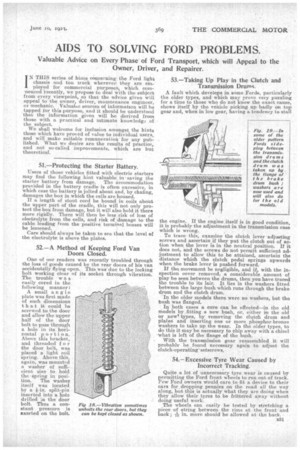AIDS TO SOLVING FORD PROBLEMS.
Page 15

If you've noticed an error in this article please click here to report it so we can fix it.
Valuable Advice on Every Phase of Ford Transport, which will Appeal to the Owner, Driver, and Repairer.
IN THIS series of hints eoncerning-. the Ford light chassis and ton truck wherever they are employed for commercial purposes, which cornnerieed 'recently, we propose to deal With the subject from every viewpoint, so that the advice given will appeal tothe owner, driver, maintenance engineer, or mechanic. Valuala sources of infermation will he tapped for this purpose, and it should be understood that the information given will be derived from those with a practical and intimate knowledge of . the subject.
We shall welcome for inclusion amongst the hints those which have proved of value to individual users, and will make suitable remu.neration. for any published. What we desire are the results of practice, and not so-called improvements, vsihich are but theoretical.
5E—Protecting the Starter Battery.
Users of those vehicles fitted with electric starters may find the following hint valuable insaving the starter battery from damage.The accommodation provided in the battery cradle is often excessive, in -which case the battery is jolted about and, by chafing, damages the box in which the cells are housed.
If a length of stout cord be bound in coils about the upper part of the cradle, this will not only protect the box from damage, but it will also hold it there more rigidly. There will then be less risk of loss of electrolyte from the cells, and risk of damage to the cable leading from the positive' termi al bosses will be lessened.
Care should always be taken to see that the level of the electrolyte is above the plates,
52.—A Method of Keeping Ford Van Doors Closed.
One of our readers was recently troubled through the loss of goods caused by the rear doors of his van accidentally flying open. This was due to the locking bolt working clear of its socket through vibration. The trouble w a s easily cured in the following manner : A small angle plate was first made of such dimensions t hat it could be screwed to the door and allow the upper half of the door bolt to pass through a hole in its horizontal portion. Above this bracket, and threaded f o r the door bolt, was placed a light coil spring. Above this, again, was mounted a washer of sufficient .size to hold the spring in position. The washer itself was located by a *-in. split-pin insetted into a hole drilled in the door bolt. Thus a constant pressure is exerted on the bolt.
53.—Taking Up Play in the Clutch and Transmission Drums.
A fault which develops in some Fords, particularly the older types, and which may prove very puzzling for a time to those -who do not know the exact cause, shows itself by the vehicle picking up badly on top gear and, when in low gear, having a tendency to stall
the engine. If the engine itself is in good condition, it is probably the adjustment in the transmission case which is wrong.
To trace this, examine the clutch lever adjusting screws and ascertain if they put the clutch out of action when the lever is in the neutral position. If it does not, and the screws do not permit sufficient adjustment to allow this to be attained, ascertain the distance which the clutch pedal springs upwards when. the brake lever is pushed forward.
If the movement be negligible, and if, with the inspection cover removed; a considerable amount of play be seen between the drums, then you have traced the trouble to its lair. It lies in the washers fitted between the large bush which runs through the brake drum and the clutch drum.
In the older models there were no washers, but the bush was flanged.
In both cases a cure can be effected—in the old models by fitting a new bush, or, either in the old or new. types, by removing the clutch drum and plates and inserting one or more phosphor-bronze washers to take up the wear. In the older types, to do this it may be necessary to chip away with a chisel what is left of the flange of the bush. , With the transmission gear reassembled it will probably be found necessary again to adjust the clutch-operating setscrews.
54.—Excessive Tyre Wear Caused by Incorrect Tracking.
Quite a lot of unnecessary tyre wear is caused by permitting the Ford front wheels to run out of track. Few Ford owners would care to fit a device to their cars far, dropping pennies on the road all the way along, but this is actually what they are doing when they allow their tyres to be frittered away without doing useful work. The wheels, can easily be tested by stretching a piece of string between the rims at the front .and back ; if in. more should be allowed at the back.




























